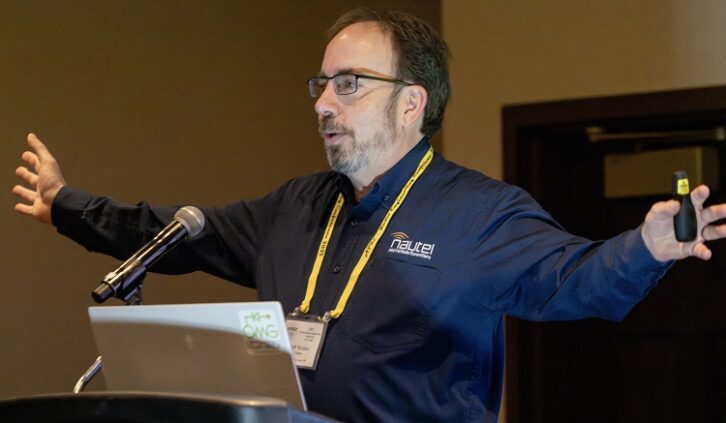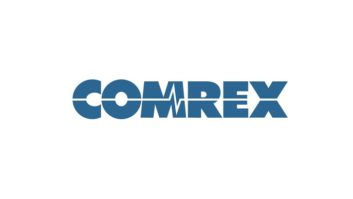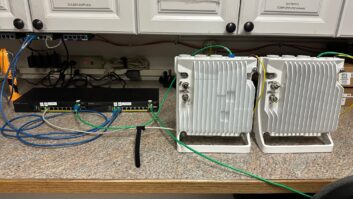This interview is one in a series that appear in the Radio World ebook “Getting Data Up the Hill” exploring trends in studio/transmitter links.
Jeff Welton is the regional sales manager, Eastern U.S., for Nautel. “I was hired as a field service tech taking the calls and crawling through the equipment at Zero Dark :30.” Now he has been with the company for almost 35 years and is an in-demand speaker on topics ranging from IT security to grounding and lightning protection. He still crawls through the occasional transmitter.
Radio World: We’re exploring how stations get their audio and data “up the hill” to the transmitter in 2025. What’s the most notable trend?
Jeff Welton: The biggest thing is that, more and more, it is ALL data, even the audio.
It used to be that an IP connection was on the “would be nice to have … someday” list. But it is rapidly becoming more of a requirement than an option. You can still get the job done without an IP link, but if you want to take full advantage of telemetry offered, redundancy options or the latest technology, having that IP link is fast becoming a necessity.
As we proceed with advances in virtualization and content delivery, this will become even more apparent.

RW: What are the most common types of calls and questions you get from radio stations about their IP links, and what can we learn from them?
Welton: Two of the biggest tend to be related to throughput and stability — whether latency or just the ability to make a connection.
You “could” deliver audio over an LTE modem in a questionable coverage area, and this might be suitable for backup purposes in a pinch, but is it recommended? Probably not.
By the same token, some audio over IP requires several MBps of throughput. Sending that over a 30-mile 900 MHz data link might be problematic. It’s always good to determine what you need to send over the link, get a good picture of the link budget, then allow for future growth. Not just 10–25% headroom, but at least two to three times what you think you need, if not more.
Beyond that, we get a lot of trouble calls that boil down to basic network configuration issues — not a problem with our equipment per se, but if you can’t get the RDS to the receiver, the transmitter is the first thing you think about.
Having IT experts available, whether on staff or via contract with a managed services provider, is up to you, but having somebody with intrinsic knowledge of network setup and management will be crucial.
RW: How can a broadcaster choose the best option from among the many choices available, meaning licensed or unlicensed, the different bands and so forth?
Welton: That is like asking me what car you should buy! There are several questions they will need to answer: How much data do they need to move, how congested are the various bands in their market(s), is there line of sight between studio and transmitter, is cable or fiber available, or will this need to be a wireless link?
In some cases, if the decision is made to go wireless, the first contact should probably be to the nearest SBE chapter, if there’s one available; they will frequently have a volunteer frequency coordinator who can provide some insight. In addition, reaching out to local ISPs could give an idea as to availability of fiber or cable connections — again, the requirement to have engineering assistance with solid network management knowledge, whether in-house or contracted, will be key to getting this question answered.
RW: What about the cloud, what are the implications for STL infrastructure?
Welton: The first things that come to mind are throughput, stability and security. Running all content over IP links, whether wired or wireless, will almost always involve public internet at some point, which absolutely increases the need for improving security — and this is something we, as an industry, do not do really well at.
When I can use an IoT search engine and see over 1,300 of a common brand of audio codec visible online, and when I find about 20 transmitters of various makes online, we need to do better. Much better.
Keep in mind that, even if not using default user names and passwords — and many still are –—a visible device is sending an invitation to be compromised.
We, as an industry, can definitely improve when it comes to IT security. The biggest things that come to mind are education and VPNs.
Education, because roughly 80% of malware and ransomware attacks occur because somebody “clicked that link” or “plugged in that USB stick that they were using at such and such hotel business office, or this or that remote.”
VPNs, because once you’ve educated everybody inside the operation, an encrypted link goes a long way toward keeping everybody else out.
These days, the cheapest router available at big box stores will have VPN capabilities built in. If you don’t want to configure the hardware box, there are always software (usually subscription) VPN services available. But education of anybody touching your network is key. Having written (and enforced) IT security policies goes a long way.
RW: Many sites still do not have cell or hardwire connectivity.
Welton: There are a couple of options here: Wi-Fi bridges (IP links) if there’s decent line of sight, or LEO satellite, such as Starlink and others. Again, the distance and the throughput requirement will go a long way toward determining what works.
A wireless IP bridge is a one-time cost when run on a closed network, whereas low earth orbit satellite internet will come with a monthly bill as well as heightened security requirements.
There are some options for conventional satellite IP delivery, but those come with enough challenges — rain fade, potential loss of spectrum — that they should be researched carefully.
RW: I’m told that many transmitter sites also still lack substantial IT infrastructure. What are the implications?
Welton: At the moment, it’s not a huge issue, although it can increase time required to troubleshoot, vs. being able to have the factory log directly into the equipment and diagnose remotely via IP.
As technology evolves — with more AoIP, or with virtualized HD air chains, or as we look to the future with EAS as a software payload — the sites that are able to provide IT connectivity are going to have an advantage over those who can’t, both in terms of being able to get back on air faster in the event of a failure — whether by providing alternate paths or due to manufacturers being able to remotely troubleshoot — and in terms of the services they will be able to provide.
Some examples could include metadata delivery — RDS artist/title/advertising, or HD program data and artwork/advertiser logos — possibly weather-related content, future developments, etc. As I mentioned, connectivity increasingly is going to become a necessity rather than a luxury.
RW: What do natural disasters like the ones in California and North Carolina teach us about keeping links operating?
Welton: Redundancy is key. If using public internet, assume it will be down during a natural disaster, or at the very least so overwhelmed as to be unreliable for time-critical content. The same holds true for cellular networks.
Closed networks will require backup power at both ends and every access point, there’s always the chance that the tower holding the antenna will be gone, so multiple paths will be important. Basically, the same considerations used to ensure delivery via analog radio STLs would apply to an IP STL.
If there’s no antenna at one end, at the other end or both, there will be no signal, so having as many options as possible will help minimize that risk.
RW: What other best practices do you recommend to ensure continuity of operations?
Welton: If you are using public internet for any part of the delivery path, have multiple ISPs … and make sure that they’re not both using the same backbone.
For example, some smaller ISPs will contract space on the pipe of a major provider. Thus, if the big pipe suffers backhoe fade, the smaller ISP will be down as well, so dual ISPs only help if they’re using different hardware.







